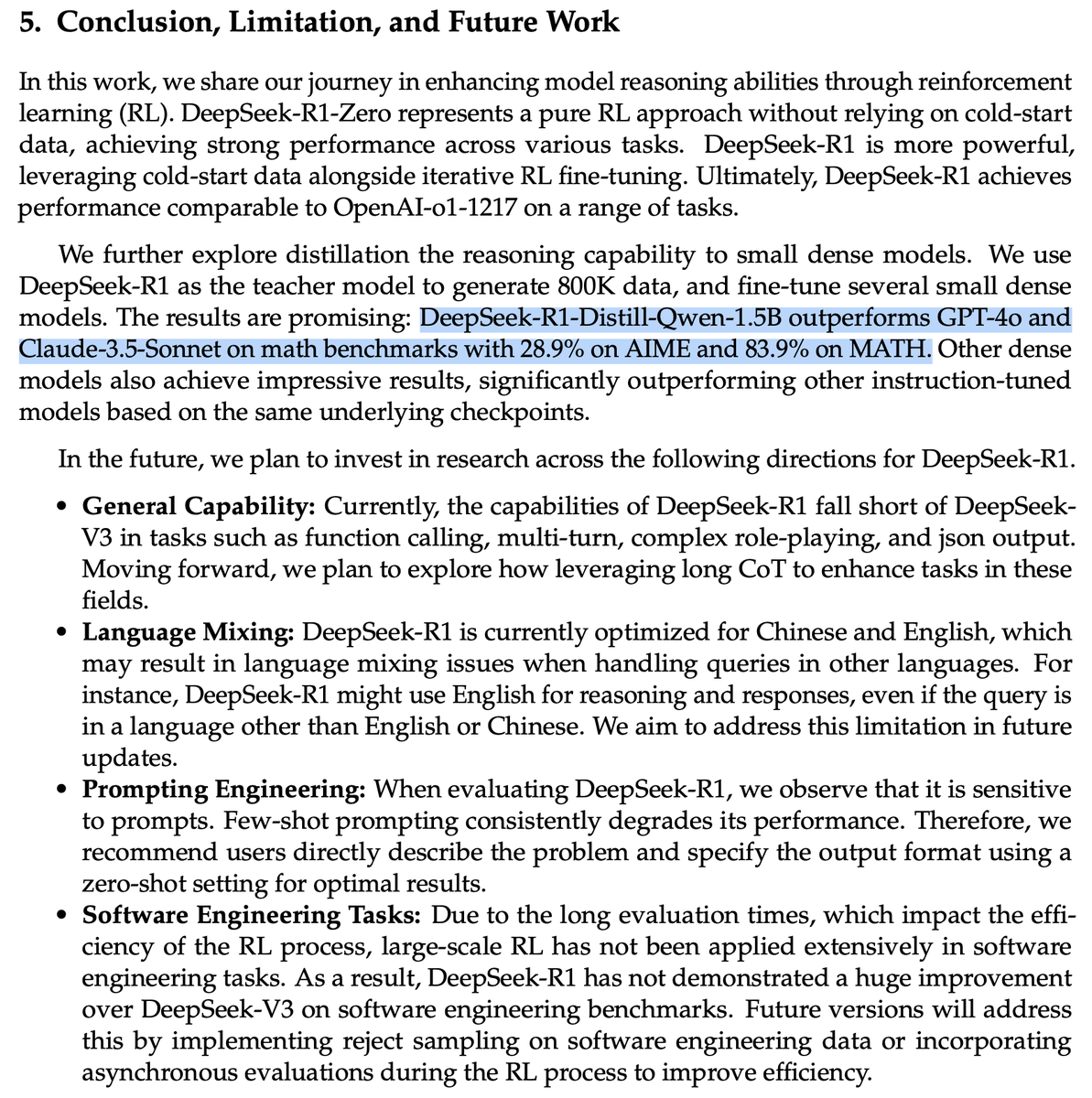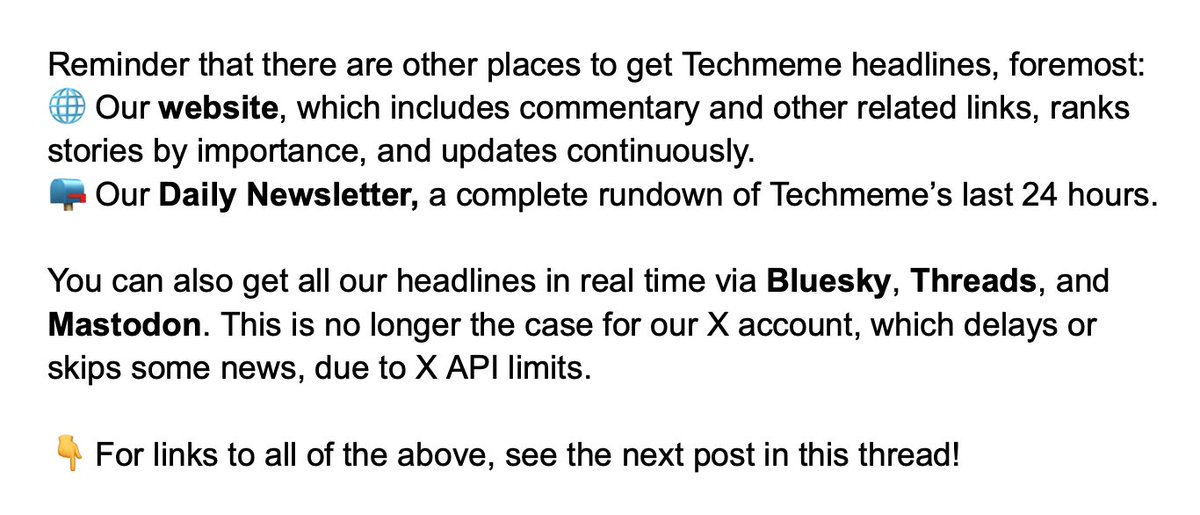1/42
@reach_vb
"DeepSeek-R1-Distill-Qwen-1.5B outperforms GPT-4o and Claude-3.5-Sonnet on math benchmarks with 28.9% on AIME and 83.9% on MATH."
1.5B did WHAT?

2/42
@reach_vb
repo:
deepseek-ai/DeepSeek-R1-Distill-Qwen-1.5B · Hugging Face
3/42
@thegenioo
but is it better at coding compared to sonnet new?
4/42
@reach_vb
No, R1 series models aren’t better than V3 on coding, that’s what DeepSeek would work at the next step
They are still pretty powerful tho
5/42
@iatharvkulkarni
How do you run these models? I see that you post a lot of hugging face models, how do you personally run them? Any tool that would help me get going as quickly as possible locally?
6/42
@reach_vb
llama.cpp or transformers, let me make a quick notebook actually
7/42
@leo_grundstrom
How fast is it?
8/42
@reach_vb
Reasonably fast on an old T4, try it out yourself:
[Quoted tweet]
Try out R1 Distill Qwen 1.5B in a FREE Google Colab!
The vibes are looking gooood!
https://video.twimg.com/ext_tw_video/1881377422135676928/pu/vid/avc1/1670x1080/wUafm6PII4xXizvR.mp4
9/42
@antonio_spie
Can SOMEONE PLEASE TELL ME HOW MANY GBS TO INSTALL LOCALLY??
10/42
@reach_vb
You can try the 1.5B directly here on a free Google colab
[Quoted tweet]
Try out R1 Distill Qwen 1.5B in a FREE Google Colab!
The vibes are looking gooood!
https://video.twimg.com/ext_tw_video/1881377422135676928/pu/vid/avc1/1670x1080/wUafm6PII4xXizvR.mp4
11/42
@ArpinGarre66002
Dubious
12/42
@reach_vb
Ha, the vibes are strong, I don’t care much about the benchmark, but for a 1.5B it’s pretty strong, try it out yourself:
[Quoted tweet]
Try out R1 Distill Qwen 1.5B in a FREE Google Colab!
The vibes are looking gooood!
https://video.twimg.com/ext_tw_video/1881377422135676928/pu/vid/avc1/1670x1080/wUafm6PII4xXizvR.mp4
13/42
@gordic_aleksa
overfit is the word
14/42
@reach_vb
Vibe checks look pretty good tho, been playing with it on Colab - not sonnet or 4o like but deffo pretty strong for a 1.5B
[Quoted tweet]
Try out R1 Distill Qwen 1.5B in a FREE Google Colab!
The vibes are looking gooood!
https://video.twimg.com/ext_tw_video/1881377422135676928/pu/vid/avc1/1670x1080/wUafm6PII4xXizvR.mp4
15/42
@CEOofFuggy
I doubt it's good in general tho, but I'll definitely have to try 14B version etc.
16/42
@reach_vb
think 32B or 70B would be golden
17/42
@snowclipsed
@vikhyatk what if you used this as the text model
18/42
@reach_vb
that would be fire - but I doubt you'd get as much benefit from this, model is a yapper
19/42
@victor_explore
[Quoted tweet]
DeepSeek today
https://video.twimg.com/ext_tw_video/1881340096995364864/pu/vid/avc1/720x720/yN45olzqLvBZt_f_.mp4
20/42
@reach_vb
hahaha, how do you create these, it's amazing!
21/42
@AILeaksAndNews
We are accelerating quickly
3.5 sonnet that can run locally
22/42
@reach_vb
maybe the 32B/ 70B is at that level, I doubt 1.5B will be at that level haha
23/42
@edwardcfrazer
How fast is it
24/42
@reach_vb
On their API it’s pretty fast!
25/42
@anushkmittal
1.5b? more like 1.5 based
26/42
@reach_vb
hahahaha!
27/42
@Yuchenj_UW
Unbelievable.
We will have super smart 1B models in the future, running locally on our phone.
28/42
@reach_vb
I call it Baby AGI
[Quoted tweet]
Try out R1 Distill Qwen 1.5B in a FREE Google Colab!
The vibes are looking gooood!
https://video.twimg.com/ext_tw_video/1881377422135676928/pu/vid/avc1/1670x1080/wUafm6PII4xXizvR.mp4
29/42
@dhruv2038
Yeah this is sus.
30/42
@reach_vb
gotta vibe check it ofc
31/42
@ftmoose
lol

32/42
@reach_vb
I love the way it thinks
33/42
@_ggLAB
yet cannot answer historical events.

34/42
@reach_vb
literally doesn't matter, as long as it works for your own use-cases.
35/42
@AntDX316

36/42
@nooriefyi
this is huge. parameter count is so last year.
37/42
@baileygspell
"few shot prompts degrade peformance" def overfit
38/42
@seo_leaders
Going to have to give that model a run up for sure
39/42
@priontific
I'm so psyched holy moly - I'm also super pumped, I think we can squeeze so much by speculative drafting w/ these tiny models. Results in a few hours once I've finished downloading -- stay tuned!!
40/42
@ionet
at first it seemed like humans being outperformed like that by AI, now AI doing the same to other AI

41/42
@joysectomy
Western cultures are bad at math, Eastern cultures teach math in a bottoms up way. Wonder how much of a factor that is in the consistent perf gap between these models
42/42
@ChaithanyaK42
This is awesome
To post tweets in this format, more info here: https://www.thecoli.com/threads/tips-and-tricks-for-posting-the-coli-megathread.984734/post-52211196
@reach_vb
"DeepSeek-R1-Distill-Qwen-1.5B outperforms GPT-4o and Claude-3.5-Sonnet on math benchmarks with 28.9% on AIME and 83.9% on MATH."
1.5B did WHAT?

2/42
@reach_vb
repo:
deepseek-ai/DeepSeek-R1-Distill-Qwen-1.5B · Hugging Face
3/42
@thegenioo
but is it better at coding compared to sonnet new?
4/42
@reach_vb
No, R1 series models aren’t better than V3 on coding, that’s what DeepSeek would work at the next step
They are still pretty powerful tho
5/42
@iatharvkulkarni
How do you run these models? I see that you post a lot of hugging face models, how do you personally run them? Any tool that would help me get going as quickly as possible locally?
6/42
@reach_vb
llama.cpp or transformers, let me make a quick notebook actually
7/42
@leo_grundstrom
How fast is it?
8/42
@reach_vb
Reasonably fast on an old T4, try it out yourself:
[Quoted tweet]
Try out R1 Distill Qwen 1.5B in a FREE Google Colab!
The vibes are looking gooood!
https://video.twimg.com/ext_tw_video/1881377422135676928/pu/vid/avc1/1670x1080/wUafm6PII4xXizvR.mp4
9/42
@antonio_spie
Can SOMEONE PLEASE TELL ME HOW MANY GBS TO INSTALL LOCALLY??
10/42
@reach_vb
You can try the 1.5B directly here on a free Google colab
[Quoted tweet]
Try out R1 Distill Qwen 1.5B in a FREE Google Colab!
The vibes are looking gooood!
https://video.twimg.com/ext_tw_video/1881377422135676928/pu/vid/avc1/1670x1080/wUafm6PII4xXizvR.mp4
11/42
@ArpinGarre66002
Dubious
12/42
@reach_vb
Ha, the vibes are strong, I don’t care much about the benchmark, but for a 1.5B it’s pretty strong, try it out yourself:
[Quoted tweet]
Try out R1 Distill Qwen 1.5B in a FREE Google Colab!
The vibes are looking gooood!
https://video.twimg.com/ext_tw_video/1881377422135676928/pu/vid/avc1/1670x1080/wUafm6PII4xXizvR.mp4
13/42
@gordic_aleksa
overfit is the word
14/42
@reach_vb
Vibe checks look pretty good tho, been playing with it on Colab - not sonnet or 4o like but deffo pretty strong for a 1.5B
[Quoted tweet]
Try out R1 Distill Qwen 1.5B in a FREE Google Colab!
The vibes are looking gooood!
https://video.twimg.com/ext_tw_video/1881377422135676928/pu/vid/avc1/1670x1080/wUafm6PII4xXizvR.mp4
15/42
@CEOofFuggy
I doubt it's good in general tho, but I'll definitely have to try 14B version etc.
16/42
@reach_vb
think 32B or 70B would be golden
17/42
@snowclipsed
@vikhyatk what if you used this as the text model
18/42
@reach_vb
that would be fire - but I doubt you'd get as much benefit from this, model is a yapper
19/42
@victor_explore
[Quoted tweet]
DeepSeek today
https://video.twimg.com/ext_tw_video/1881340096995364864/pu/vid/avc1/720x720/yN45olzqLvBZt_f_.mp4
20/42
@reach_vb
hahaha, how do you create these, it's amazing!
21/42
@AILeaksAndNews
We are accelerating quickly
3.5 sonnet that can run locally
22/42
@reach_vb
maybe the 32B/ 70B is at that level, I doubt 1.5B will be at that level haha
23/42
@edwardcfrazer
How fast is it
24/42
@reach_vb
On their API it’s pretty fast!
25/42
@anushkmittal
1.5b? more like 1.5 based
26/42
@reach_vb
hahahaha!
27/42
@Yuchenj_UW
Unbelievable.
We will have super smart 1B models in the future, running locally on our phone.
28/42
@reach_vb
I call it Baby AGI
[Quoted tweet]
Try out R1 Distill Qwen 1.5B in a FREE Google Colab!
The vibes are looking gooood!
https://video.twimg.com/ext_tw_video/1881377422135676928/pu/vid/avc1/1670x1080/wUafm6PII4xXizvR.mp4
29/42
@dhruv2038
Yeah this is sus.
30/42
@reach_vb
gotta vibe check it ofc
31/42
@ftmoose
lol

32/42
@reach_vb
I love the way it thinks
33/42
@_ggLAB
yet cannot answer historical events.

34/42
@reach_vb
literally doesn't matter, as long as it works for your own use-cases.
35/42
@AntDX316
36/42
@nooriefyi
this is huge. parameter count is so last year.
37/42
@baileygspell
"few shot prompts degrade peformance" def overfit
38/42
@seo_leaders
Going to have to give that model a run up for sure
39/42
@priontific
I'm so psyched holy moly - I'm also super pumped, I think we can squeeze so much by speculative drafting w/ these tiny models. Results in a few hours once I've finished downloading -- stay tuned!!
40/42
@ionet
at first it seemed like humans being outperformed like that by AI, now AI doing the same to other AI
41/42
@joysectomy
Western cultures are bad at math, Eastern cultures teach math in a bottoms up way. Wonder how much of a factor that is in the consistent perf gap between these models
42/42
@ChaithanyaK42
This is awesome
To post tweets in this format, more info here: https://www.thecoli.com/threads/tips-and-tricks-for-posting-the-coli-megathread.984734/post-52211196




























